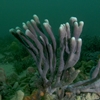General Description
A brown to purple sponge species with encrusting to lobate form. Size of about 50 cm.
Biology
This cosmopolitan genus contains species found from the tropics to Antarctic waters, and over a wide depth range.
Habitat
Reef and jetty areas, to depth of 5 m.
Sponge gardens
Reefs
Distribution guide
Port Phillip in Victoria.
Species Group
Depth
Water Column
Max Size
50 cm
Diet
Plankton or particles
Commercial Species
No
Global Dispersal
Recorded in Australia
Species Code
sp. MoV 6668
Identify
Conservation Status
- DSE Advisory List : Not listed
- EPBC Act 1999 : Not listed
- IUCN Red List : Not listed






